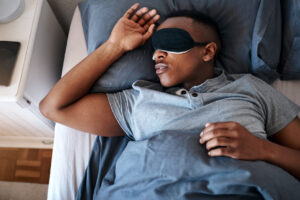Narcolepsy Symptoms
- Narcolepsy is characterized by overwhelming and persistent daytime sleepiness.
- Cataplexy, which involves sudden muscle weakness, is a common symptom of type 1 narcolepsy.
- Many people with narcolepsy experience hallucinations when starting to fall asleep.
- Understanding the signs of narcolepsy and speaking to a doctor is crucial for diagnosis and management.
Narcolepsy is a sleep disorder that affects one in 2,000 Americans . Although people may begin experiencing symptoms at any age, narcolepsy most often begins between 7 and 25 years old. After symptoms begin, excessive sleepiness can quickly begin to interfere with a person’s ability to function at home, school, and in the workplace.
Many symptoms of narcolepsy are common to other medical conditions and, because of this, narcolepsy can remain undiagnosed for many years. Understanding the symptoms of narcolepsy is an important step towards accurately diagnosing and treating this chronic and potentially debilitating sleep disorder.
What Causes Narcolepsy Symptoms?
Symptoms of narcolepsy are usually related to the loss of brain cells that produce neurotransmitters called orexins. Orexins have many important roles in the body, two of which are to consolidate wakefulness and suppress REM sleep . Consolidating wakefulness is important because it allows people to maintain alertness for long periods throughout the day.
Without sufficient orexin-producing neurons, the body cannot appropriately maintain sleep-wake cycles. Sleep is less consolidated, leaving people feeling tired throughout the day and feeling a need to take frequent naps. It’s common for people with narcolepsy to experience an intense need for sleep at inopportune times.
Narcolepsy also causes the body to transition rapidly between sleeping and waking states. People with narcolepsy fall asleep quickly and enter REM sleep much faster than those without this disorder. Narcoleptic patients wake up often during the night and spend time in abnormal intermediate states in which they are neither fully asleep nor fully awake — manifesting as cataplexy, sleep paralysis, and hallucinations.
The connection between a lack of orexins and narcolepsy symptoms is well established, but not all people with narcolepsy have a loss of orexin-producing neurons. There are two types of narcolepsy — type 1 and type 2 — and orexin deficiencies are known to cause symptoms only in people with narcolepsy type 1.
People diagnosed with narcolepsy type 1 have 85% to 95% fewer neurons that produce orexins than people without this condition. People diagnosed with narcolepsy type 2 usually have normal levels of orexins and less severe narcolepsy symptoms. The cause of symptoms in patients with narcolepsy type 2 is not well understood.
Symptoms of Narcolepsy
Narcolepsy symptoms are often called a tetrad, meaning that there are four core symptoms of this condition: excessive daytime sleepiness, sleep paralysis, hallucinations, and cataplexy. Although everyone with narcolepsy experiences excessive daytime sleepiness, the other symptoms are less common. Only around 10% to 15% of people with narcolepsy experience the entire tetrad of symptoms .
Excessive Daytime Sleepiness
Excessive daytime sleepiness (EDS) is often the first symptom of narcolepsy . People with narcolepsy may wake up feeling rested, only to feel tired again a short time later. Sleepiness persists no matter how much a person sleeps at night and often increases when a person is engaged in uninteresting or monotonous tasks, like watching television or sitting in a classroom. People may feel more alert when performing tasks that hold their attention.
In addition to persistent sleepiness, patients with narcolepsy often describe what is referred to as “sleep attacks.” During a sleep attack, extreme sleepiness comes on quickly and the need to sleep is virtually irresistible. People may fall asleep at any moment, with brief naps ranging from just a few seconds to several minutes . They often wake from these short naps feeling much more alert and awake.
During lapses in attention or brief periods of sleep, people with narcolepsy may perform activities with no conscious awareness and little memory of them afterward. While performing habitual activities, like eating, talking or typing, they may fall asleep and automatically continue the activity. Usually, their performance declines, with a common example being writing that becomes an illegible scribble during brief sleep attacks.

Sleep Paralysis
Sleep paralysis is a temporary loss of voluntary muscle control while waking up or falling asleep. A person remains fully conscious during sleep paralysis, but is unable to speak or move. Periods of sleep paralysis can last for several minutes and, upon waking, people regain the ability to move and speak. About 25% of people with narcolepsy experience sleep paralysis .
In most people without narcolepsy, REM sleep is reached about 60 to 90 minutes after falling asleep . During REM sleep there is increased brain activity, and vivid dreaming is common. REM sleep also involves a temporary muscle paralysis called atonia. Atonia prevents dreams from being acted out during sleep and normally ends when a person wakes up.
People with narcolepsy enter REM sleep frequently, often within 15 minutes of falling asleep, and experiences normally found in REM sleep may bleed into wakefulness. When atonia persists after a person wakes up, they experience sleep paralysis. If dreaming normally seen during REM sleep also continues during wakefulness, it’s experienced by some patients as hallucinations.
Hallucinations
Hallucinations can be a frightening experience for people with narcolepsy. These hallucinations most often occur when someone is falling asleep, but can also happen while a person is waking up. Hallucinations are usually visual, like seeing something or someone in the bedroom, but may also be multimodal, meaning they involve multiple senses, like taste, touch, hearing, or smell.
Hypnagogic hallucinations, those that occur when a person is falling asleep, affect about one-third of people with narcolepsy . Much like sleep paralysis, researchers believe that hallucinations represent REM sleep phenomenon intruding into wakefulness.
Cataplexy
Cataplexy involves a sudden loss of muscle tone while a person is awake. Unlike other conditions that involve loss of muscle control, like fainting and seizure disorders, people experiencing cataplexy remain fully conscious. Cataplexy may be triggered by strong emotions , like laughter, surprise, anger, and excitement. Only people with type 1 narcolepsy experience cataplexy.
Sleep paralysis is similar to cataplexy in that it represents a paralysis of muscle activity that normally only occurs during REM sleep. Sleep paralysis occurs on the edges of sleep, but cataplexy occurs after a person is fully awake.
Mild episodes of cataplexy may only last a few seconds and involve a small number of muscle groups, such as the eyelids. More severe episodes of cataplexy may last several minutes and involve a total loss of voluntary muscle control, resulting in complete, but temporary, paralysis. Although these episodes can be frightening, they are typically safe if the person is in an appropriate environment.
Disrupted Nighttime Sleep
While doctors have long recognized the classic tetrad of narcolepsy symptoms, recent research suggests that disrupted nighttime sleep is also a common occurrence in people with narcolepsy. Affecting between 30 and 95% of patients , disrupted nighttime sleep might be a stand-alone symptom of narcolepsy, or it could be caused by another sleep disorder. Other sleep disorders seen in people with narcolepsy include insomnia, sleep apnea, REM sleep behavior disorders, and periodic limb movement disorder.
Interestingly, despite disrupted sleep patterns, many people with narcolepsy often sleep the same amount of hours as people without this disorder sleep. Rather than having consolidated sleep at night like most people, sleep time in people with narcolepsy often adds up from short periods of sleep throughout the day and the night.
Narcolepsy Symptoms in Children
When narcolepsy begins in childhood or adolescence, it often begins with excessive daytime sleepiness. This increased tiredness may result in sleep times that are longer than usual, called hypersomnia, as well as a return to daytime napping typically seen in infants and toddlers.
As narcolepsy progresses, long sleep times might resolve as nighttime sleep becomes more disrupted and there’s an increase in vivid dreams and nighttime awakenings. While narcolepsy is a chronic, lifelong condition, symptoms do not typically worsen as a person grows older.
Other Health Conditions Associated with Narcolepsy
Research has demonstrated that patients with narcolepsy are at an increased risk for several medical conditions. People with narcolepsy face an increased risk of cardiovascular and metabolic conditions such as high blood pressure, high cholesterol, obesity, and diabetes.
One reason for the increased prevalence of these conditions in people with narcolepsy may be the multiple roles orexins play in the body. In addition to causing issues in maintaining sleep-wake cycles, a loss of orexin-producing neurons can also affect physical activity and weight gain, nighttime blood pressure, and the buildup of plaque in the arteries — all potential causes of heart disease.
Narcolepsy is also associated with psychiatric disorders , including attention deficit hyperactivity disorder (ADHD), anxiety, eating disorders, depression, and schizophrenia. Researchers hypothesize that lifestyle changes and impairment caused by the symptoms of narcolepsy may lead to the development of psychiatric disorders, or that both narcolepsy and psychiatric disorders share similar causes. While the impact of narcolepsy on mental health is significant, with up to 57% of people with narcolepsy also experiencing depression, more research is needed to understand the complex relationship between narcolepsy and psychiatric disorders.
References
13 Sources
-
Mahoney, C. E., Cogswell, A., Koralnik, I. J., & Scammell, T. E. (2019). The neurobiological basis of narcolepsy. Nature reviews Neuroscience, 20(2), 83–93.
https://pubmed.ncbi.nlm.nih.gov/30546103/ -
Brown, R. E., Basheer, R., McKenna, J. T., Strecker, R. E., & McCarley, R. W. (2012). Control of sleep and wakefulness. Physiological reviews, 92(3), 1087–1187.
https://pubmed.ncbi.nlm.nih.gov/22811426/ -
Thannickal, T. C., Moore, R. Y., Nienhuis, R., Ramanathan, L., Gulyani, S., Aldrich, M., Cornford, M., & Siegel, J. M. (2000). Reduced number of hypocretin neurons in human narcolepsy. Neuron, 27(3), 469–474.
https://pubmed.ncbi.nlm.nih.gov/11055430/ -
Loachimescu, O. C., (2019, November 13). Narcolepsy. BMJ Best Practice., Retrieved February 15, 2021 from
https://bestpractice.bmj.com/topics/en-us/428 -
National Organization for Rare Disorders. (2017). Narcolepsy., Retrieved February 15, 2021 from
https://rarediseases.org/rare-diseases/narcolepsy/ -
American Academy of Sleep Medicine. (2014). The International Classification of Sleep Disorders – Third Edition (ICSD-3). Darien, IL.
https://aasm.org/ -
Mamelak M. (2009). Narcolepsy and depression and the neurobiology of gammahydroxybutyrate. Progress in Neurobiology, 89(2), 193–219.
https://pubmed.ncbi.nlm.nih.gov/19654034/ -
National Institute of Neurological Disorders and Stroke. (2020, September 30). Narcolepsy fact sheet., Retrieved February 15, 2021, from
https://www.ninds.nih.gov/Disorders/Patient-Caregiver-Education/fact-sheets/narcolepsy-fact-sheet -
Schwab, R. J., (2020, June). Narcolepsy. Merck Manual Consumer Version., Retrieved February 15, 2021, from
https://www.merckmanuals.com/home/brain,-spinal-cord,-and-nerve-disorders/sleep-disorders/narcolepsy -
Dauvilliers, Y., Arnulf, I., & Mignot, E. (2007). Narcolepsy with cataplexy. The Lancet, 369(9560), 499–511
https://pubmed.ncbi.nlm.nih.gov/17292770/ -
Roth, T., Dauvilliers, Y., Mignot, E., Montplaisir, J., Paul, J., Swick, T., & Zee, P. (2013). Disrupted nighttime sleep in narcolepsy. Journal of Clinical Sleep Medicine, 9(9), 955–965
https://pubmed.ncbi.nlm.nih.gov/23997709/ -
NarcolepsyLink. (2020, November 2). Comorbidities. NarcolepsyLink., Retrieved February 15, 2021, from
https://www.narcolepsylink.com/comorbidities-risk/comorbidities/ -
Morse, A. M., & Sanjeev, K. (2018). Narcolepsy and psychiatric disorders: Comorbidities or shared pathophysiology?. Medical Sciences, 6(1), 16.
https://pubmed.ncbi.nlm.nih.gov/29462876/







